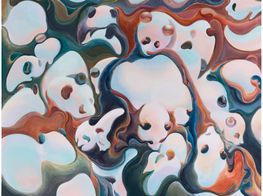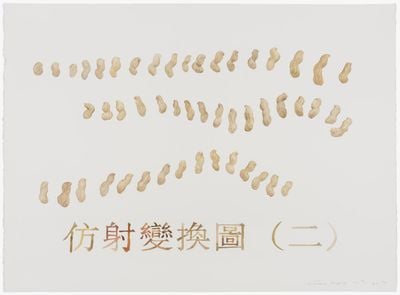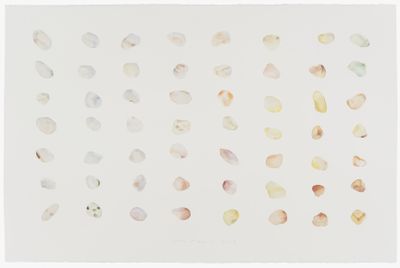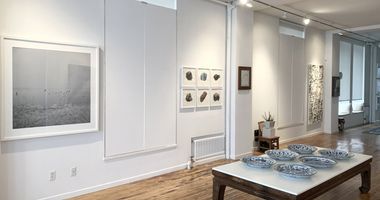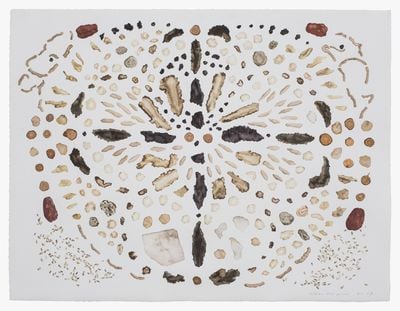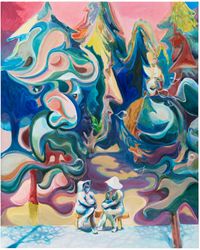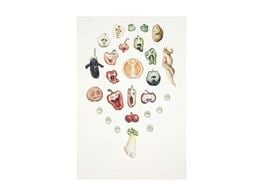Guo Hongwei on Seeing Patterns That Don’t Exist
Pareidolia—defined as the tendency to identify a specific image in a random or ambiguous visual stimulus—accounts for why we see animals in the clouds or faces in the front of cars. At Guo Hongwei: Pareidolia (3 March–4 April 2020), presented by Chambers Fine Art in New York, such phenomena can be encountered in the Beijing-based artist's recent watercolours.
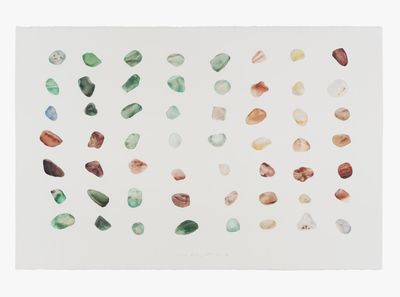
Guo Hongwei, Cosmic Candies No.3 (2018). Watercolour on paper, 67 x 102 cm. Courtesy the artist and Chambers Fine Art.
A good place to start is Poem (2017), where rows of elongated, curved, or rounded specks dot the paper. Using an earthy colour palette ranging from light beige to dark brown, Guo has spaced the forms horizontally, grouping them in twos and threes in some places to mimic the visual composition of words in a poem. Yet viewers may also read these pseudo-letters as crudely drawn numbers or, upon closer inspection, make the unexpected discovery that they recall plant seeds—the teardrop-shaped units perhaps resemble sunflower seeds, while the larger, bulbous ones describe peanuts.
In Fig 1 and Fig 2 of Affine Transformation, both completed in 2017, sunflower seeds and peanut shells reappear in rhythmic, linear waves on paper. A term used in mathematics, 'affine transformation' denotes a linear mapping method that conserves parallel relationships after it has been performed. In his paintings, the artist demonstrates examples of affine transformation—reflection, rotation, and scaling—as he portrays each seed from a different angle from its immediate neighbours in a determined study of the changes in his subjects' appearances.
Guo's affinity with botanical specimens goes back to Painting is Collecting (2012), his three-part solo exhibition held across the Beijing, Hong Kong, and New York spaces of Chambers Fine Art that included watercolour paintings of natural specimens. Inspired by the presentation format used in natural history museums, the artist arranged depictions of plants and minerals into grids, or birds and insects into irregular but balanced compositions.
Painting is Collecting – Stones No. 16 (2017) offers an example in the variously shaped and coloured stones that are locked into an orderly grid of ten by seven. Containing an abundance of related but different subjects, the painting also displays the artist's technical mastery. Where several colours exist within one specimen, he manipulates the ratio of pigment and water to capture them while leaving the unevenly distributed paint to dry with cloudy textures evocative of a stone.
An understanding of tonalities is perhaps better seen in Cosmic Candies No. 1 (2018), which shows a grid of 'cosmic candies' that shifts from light grey to yellow in overall tint as the eyes move from left to right. This evident control of the paint medium has precedents in earlier works such as the oil and watercolour paintings featured in Things, his first solo exhibition at Chambers Fine Art in Beijing in 2009. By then, he had been experimenting for some time with diluting oil paint with turpentine, then splashing water on the canvas before painting.
In Chair No. 1 (2009), the paint has dried with a crystallised texture reminiscent of oil pastel drawings. With watercolour, the artist first explored painting on moist paper as in 'Chiaroscuro' (2008–2009)—a series of monochrome paintings based on old photographs in which details become lost in the amorphous washes of greys and black. Red Plastic Bag No. 4 (2009), by contrast, has the same precise outlines as Stone No. 16 or Cosmic Candies, a result of Guo Hongwei first drawing with water-soluble coloured chalk, splashing water, then painting.
From the stillness of Stone No. 16 and Cosmic Candies, a more intuitive and enlivened turn occurs in Remedies for Sorrow Diagram No. 1 – Remedy for Depression; Remedies for Sorrow Diagram No. 3 – Cough Remedy; and Remedies for Sorrow Diagram No. 4 – Spirit Healing Tea (all 2019). Stemming from the artist's research into botany, these diagrams are composed of ingredients traditionally used in Chinese medicine—here, arranged in a way to encourage pareidolia. In Remedy for Depression, it is possible to make out a face with an angled eyebrow in the upper right corner, and potentially another wearing a surprised expression, while the almost symmetric, kaleidoscopic scene in Spirit Healing Tea spans outward from the face with a pair of rounded eyes and a joyful mouth in the centre.
The title Remedies for Sorrow recalls St Thomas Aquinas' 'Five Remedies against Sadness', in which a priest and doctor recommends five ways of self-care: granting yourself pleasure, permission to cry, to turn to the companionship of friends and loved ones, to contemplate, and to sleep and bathe. Guo Hongwei's watercolours may also provide that: an uplifting exercise for the mind and eyes. —[O]

